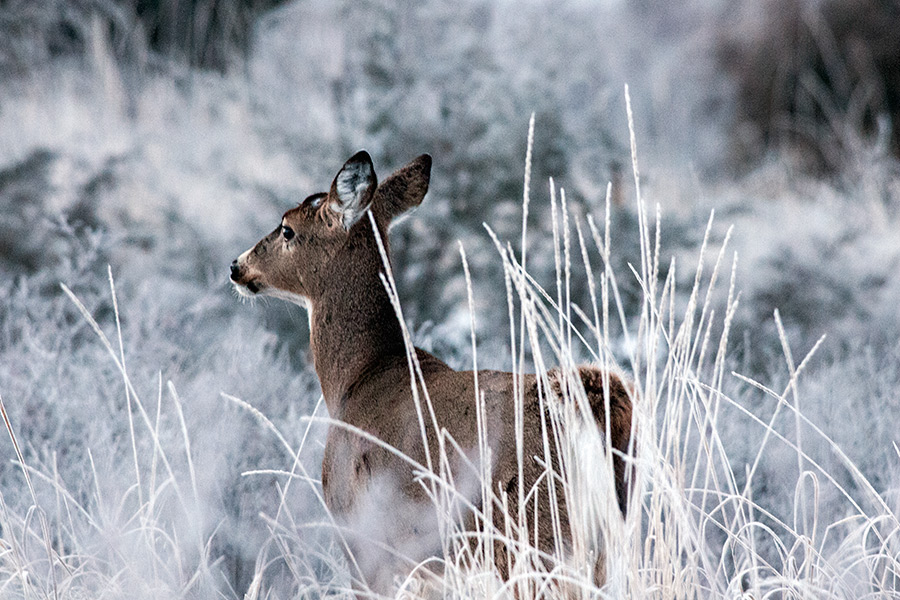In response to the recent detection of chronic wasting disease (CWD) in at least two white-tailed deer in Libby, wildlife officials with Montana Fish, Wildlife and Parks are working with local officials and members of the public to determine the most appropriate response strategy.
“We know the residents of Libby and folks around Montana are concerned about this discovery,” FWP wildlife program manager and regional CWD expert Neil Anderson said. “However, CWD is a slow-moving disease, and so while we want to be prompt in addressing public concerns, we want to be deliberate in determining how we are going to respond.”
Between late May and early July, FWP officials submitted 29 samples of white-tailed deer and mule deer for CWD testing. Two were confirmed positive for the disease and another is suspected to be positive, Anderson said.
To address concerns surrounding the contagious and fatal disease, FWP officials are hosting a series of public meetings in Libby in the coming month, with additional meetings slated to take place later this summer in Kalispell, Thompson Falls and Eureka.
This is the first time CWD has been detected in the wild on the western side of the Continental Divide in Montana.
The first meeting will be Friday, July 19. FWP will hold additional meetings on Aug. 2 and Aug. 16. The meetings will start at noon in the Ponderosa Room at Libby City Hall, 952 Spruce St.
In accordance with the state’s CWD Management Plan, the agency has assembled an Incident Command Team that includes staff from Libby, Kalispell, Bozeman and Helena, as well as Libby city officials. At the meetings, FWP staff will provide updates on the evolving CWD Response Plan.
CWD is a progressive, fatal disease affecting the nervous system of mule deer, white-tailed deer, elk and moose. If left unmanaged, it could result in long-term population declines within affected herds. All the states and provinces that border Montana, other than Idaho and British Columbia, have detected CWD in their wild deer populations.
Like many wildlife diseases, CWD can spread more quickly where animals are artificially congregated, as is common with deer roaming in developed communities or on game farms. It’s illegal to feed wildlife in Montana, officials cautioned, due in part because of the concern about wildlife diseases.
“Libby police officers are also staying vigilant on looking for sick deer in town,” Libby Police Chief Scott Kessel said, encouraging residents to report any unusual deer behavior.
If members of the public see a sick or injured deer, they should contact the emergency dispatch center at (406) 293-4112, extension 0.
For residents in the Libby area who have general information on sightings of sick deer, they should call the hotline set up by FWP at (406) 291-6539 and leave a message with their name, number, the location of the animal and the time they saw it.
While there’s no evidence CWD can infect humans, the Centers for Disease Control and Prevention (CDC) recommends not consuming meat from an animal that tests positive for CWD. The CDC also recommends testing deer, elk and moose harvested from CWD-positive areas for the disease prior to consuming.
CWD is part of a group of diseases called Transmissible Spongiform Encephalopathies (TSEs), according to Anderson. TSEs are caused by infectious, mis-folded prion proteins, which cause normal prion proteins throughout a healthy animal’s body to mis-fold, resulting in organ damage and eventual death.
CWD was first found in wild deer in Montana in October 2017. To date, CWD has been detected in Carbon, Liberty, Hill, Blaine, Phillips, Valley, Daniels, and Sheridan counties.
To prevent the spread of CWD within Montana, FWP has established CWD Management Zones in areas where CWD has been found. Hunters are prohibited from removing the carcass, head and spinal column from any deer, elk or moose harvested from these zones unless the animal has tested negative for CWD.
Chronic wasting disease is spread by virus-like particles called prions. The infectious material spreads easily between deer and elk, and can also lie dormant in soils where an animal carcass has decomposed. It is related to the same brain-damaging diseases that cause scrapie in sheep and mad cow disease in cattle.
For more information about the state’s response plan and to view a map of its CWD Management Zones, visit its CWD-specific website at fwp.mt.gov.
